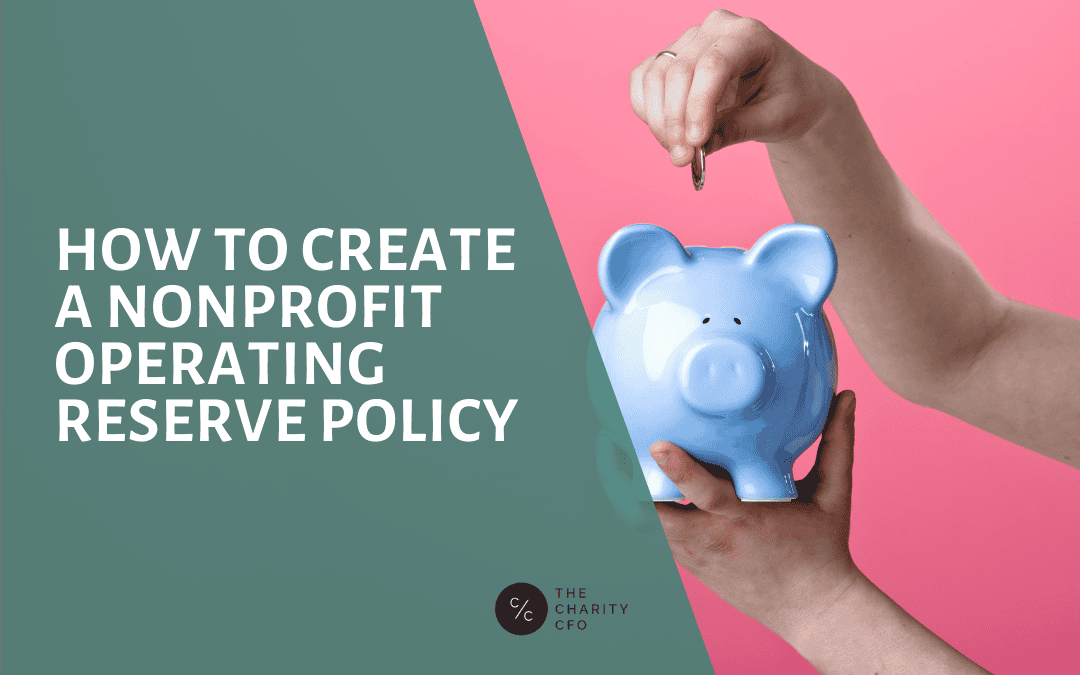How to Create A Nonprofit Operating Reserve Policy

Why does your nonprofit need an operating reserve?
A report released last year by Candid and the Center for Disaster Philanthropy estimated the worst-case scenario would lead to the closure of 38% of nonprofits in the United States.
Hopefully, we’ll fall far short of that number.
But there’s little doubt that nonprofits with reserve funds in place were more likely to survive when their offices closed suddenly and funding disappeared almost overnight in 2020.
If you’re still operating month-to-month or know that one disappointing fundraising quarter could shutter your operations, now is the time to build an operating reserve.
What is a nonprofit operating reserve?
An operating reserve is a balance of unrestricted funds (cash or highly liquid assets) that you can access in the case of emergency need.
They’re funds that you can use to keep your organization afloat in the case of unexpected events— like a pandemic, a natural disaster, or just a bad fundraising month.
PRO TIP: An operating reserve solves temporary, emergent problems, not structural financial problems. At best, it keeps you afloat and buys you time to develop new revenue streams or funding strategies.
An operating reserve is a “surplus” of resources that can help get you through tough times. But it’s also a key financial indicator that large donors, grantmakers, and watchdog agencies will want to see.
In the eyes of those outside sources (like donors, foundations, or the Better Business Bureau), your operating reserve is more than just cash on hand– it includes all of your Net Assets that don’t have Donor Restrictions, less the value of your fixed assets (like real estate, automobiles, and furniture/equipment).
If you have too little in reserve, it indicates you’re not planning ahead.
But if you have too much, they may think you’re not investing enough into your programs…
So, how much money do you need in your operating reserve?
There’s no official rule about how much you need in your nonprofit operating reserve, but United Way wants to see between 25% to 75% of your annual expenses in non-capital unrestricted net assets.
Doing some simple math (25% x 12 months = 3 months), we can safely say that you should start with a goal of at least 3 months of expenses as your operating reserve.
Once you reach that goal, keep saving and increase that reserve to 6 months of operating expenses. Depending on your organization, it may make sense for you to push that even higher.
Consider these factors when deciding how big of an operating reserve you need:
- Revenue sources:
- Do you get regular, contracted payments?
- Do you have earned revenue sources?
- Or, do you rely on grants, events, and campaigns?
- Are you dependent on 1-2 major donors? Or a single fundraising event?
- How stable are your revenue and expenses?
- What’s the economic health of your community?
- Is your region at risk for severe weather or natural disasters?
- How long has your organization been around?
- How well does your organization budget? And do you hit that budget consistently?
- Is there uncertainty (like new, unproven services) in your near future?
Your circumstances might tell you that you need an operating reserve outside of the recommended range.
And that could be okay. But you need to detail the reasons and put them in writing as part of your official operating reserve policy.
Do you really need a policy? Or can you just set some money aside?
And the most effective way to make sure the reserve is built, administered, and allocated appropriately is to create an operating reserves policy.
After all, it’s easy to say you will set aside 3-6 months of operating expenses. But a policy forces you to give real thought to how big your operating reserve needs to be. And it helps you and your team be accountable for reaching your goals.
With a policy in place, your board and executive team will know what to do with surplus funds, how reserves should be authorized and used, and the standards for reporting and monitoring their use.
If you don’t have an operating reserve policy in place, your reserves tend to be whittled down unexpectedly.
It’s like in your personal finances when you use your vacation fund to go out for pizza or pay for an oil change. Eventually, your vacation fund gets wiped out, and you have to start over.
An operating reserve policy also makes you more attractive to donors. Because it displays the proactive, prudent management practices that donors value.
How do you build an operating reserve policy?
Detail your policy in a clear and straightforward document (typically no more than 2-3 pages) that outlines your reasons for building a reserve, how you plan to structure it, and criteria for when reserve funds can be used.
But before you start building your operating reserve policy, you’ll first need to talk to your board of directors and get buy-in on the concept.
Often, the finance committee will set up a committee to determine the targeted reserve amount and prepare the policy. But in a small organization, you may need to design it yourself and present it to your board.
Here are 8 questions your operating reserve policy should answer:
1. What is your purpose for building and maintaining an operating reserve?
2. What types of reserves will be utilized (cash or other assets)?
3. What is your target level of operating reserve (of operating budget)?
4. How will you fund your operating reserve? (initially, and ongoing)
5. Who will have authority to spend the operating reserve? And what specific approvals do they need?
6. What are acceptable (and unacceptable) uses of reserve funds?
7. How will you report reserve fund balance and usage on your financial documents? (You might consider adding the reserve fund as a line item on your Statement of Financial Position)
8. What kind of investments can you make with your reserve funds, if any?
Once the draft policy is complete, you must present it to the Board for review and edits. Then, the committee and Board will finalize the policy and start implementing it.
Need Help Planning your Operating Reserve?
Developing a policy for operating reserves can help you prepare your organization for what’s to come. But if you’ve never done it before, you may not know where to start.
That’s where having an experienced partner in your corner can help.
At The Charity CFO, we focus exclusively on the unique financial challenges of nonprofit organizations everyday. And with 150+ nonprofit clients and over five decades of combined experience as nonprofit CFOs, auditors, accountants, financial directors and board members, we’re prepared to handle anything your organization can throw at us.
Expert nonprofit financial advice is part of our DNA.
When you work with our bookkeeping and accounting services, you get our expertise and advice free of charge. Whether establishing an operating reserve policy, drawing up your annual budget, or game-planning expansion options, we’re here to give our expert opinions on your organization.
So if you need an experienced financial partner to help your organization plan for a successful future, reach out to us for a free consultation.







